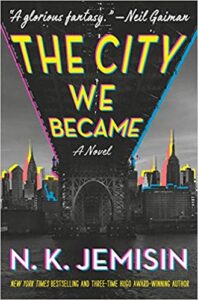The City We Became by N.K. Jemisin ( Bookshop.org | Amazon.com )
Orbit, 2020
ISBN-13 : 978-0316509848
Available: Hardcover, paperback, Kindle edition
The City We Became is the first book in a trilogy based on a short story by N.K. Jemisin titled “The City Born Great”, which focused on a young homeless Black man who becomes the avatar for New York City as it literally comes alive, and successfully battles a cosmic attack aimed at killing the city at great expense to himself.
The book begins after the events of the story, and if you haven’t read the story the beginning may be a little disorienting. The exhausted avatar of New York City, who sustained significant damage to himself, is hidden away and sleeping. It turns out that one person is not enough to sustain the life of an entire city. The five boroughs of New York, each with a distinct character, each have an avatar come alive that can defend their borough, and when they come together, they will be able to find and wake the avatar for New York City with their combined strength. They just have to find each other, choose to take on the responsibility of being their city as well as themselves, and overcome the “Woman in White,” a powerful representative from a cosmic force in an alternate reality. With one exception they are a colorful, multiracial, and argumentative group, but when push comes to shove, they are all New Yorkers who stand together. Manhattan is a younger, gay man who developed amnesia when he entered the city, but who obviously had a background steeped in violence. He has come to New York to work on a graduate degree in political science. Brooklyn is an older Black woman who was a rap artist in the early years of rap music but is now a mother and member of the city council. The Bronx is a no-nonsense part-Lenape feminist lesbian professor of fine arts who directs a nonprofit arts center for marginalized artists and members of the community. Queens is an undocumented Indian student with a gift for math who is interning on Wall Street in hopes of gaining a path to citizenship.
But Staten Island stands back from the rest of the city. She is a young white woman living in a conventional family with a father who is an abusive, xenophobic, racist cop and a mother who is a passive alcoholic housewife. She barely qualifies to work at the library, and has been cautioned about the awful people in the city and the terrible things that could happen to her there. When someone encourages her to read Lovecraft, his work confirms for her what “those people” are like (anyone who has ever said “it’s just fiction, not life” please take note). Despite the awful things that have happened to her within the walls of her own home (ranging from smashed self-esteen to attempted rape), she is more concerned with keeping others out than escaping it herself. As a white woman, it was heartbreaking for me to see her ignorance and obvious complicity with not just human but cosmic evil. I’m not familiar with Staten Island, but I really hope the portrayal here is not totally congruent with reality,
In The City We Became, extradimensional evil has grown more complex: better at planning in a way that, when cities begin to come alive, groundwork to kill it is already in place. The art gallery is attacked online by alt-right “artists” funded by a clearly sinister foundation led by the “Woman in White”, resulting in the staff getting doxxed and recieving death threats, and the building nearly burned down (this part of the book is terrifying). Brooklyn and her family are evicted from property they own outright by the same foundation, in the name of gentrification. Every chain store that replaced a community institution and changed the character of the boroughs and the city is killing it. Will Manhattan, Brooklyn, the Bronx, and Queens be able to revive the avatar of New York and save the city without the help of Staten Island, or will the city die, to be replaced with something more sinister and destructive?
While The City We Became touched on a lot of important issues (gentrification being a big one) it is also a love letter to New York City and its boroughs. Seeing the people Jemisin imagined as being these cities brought a new vividness into the way I think about the city and I loved meeting her main characters. I do feel like this book left a lot of loose ends. Who is Manhattan, really? Will we see more of his roommate? Where will the homeless avatar for New York go next? What finally happens to Staten Island? How do things change for the avatars when they go back to their daily lives? This is the first book in a trilogy, so I hope we’ll find out shortly. Recommended.
Contains: attempted rape, domestic abuse, violence, racism, body horror, tentacles







Follow Us!